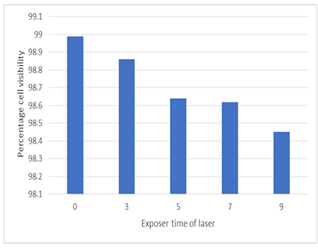Effect of Continuous Laser on The Number Lymphocyte Cells and its DNA
Abstract
The aim of this research is to evaluate the effects of a helium-neon laser on lymphocyte cells and DNA. Many different medical applications make extensive use of laser light. Like other lasers, the He-Ne laser's applicability in medicine is dependent on how laser light interacts with the biological system. The objective is to demonstrate the impact of 632.8 nm helium-neon (He-Ne) laser irradiation on human lymphocyte blood cells and their DNA. Techniques Eighty blood samples from individuals who seemed to be in good health were used in this investigation. The samples were split into two groups: thirty samples from the first group were processed solely for the purpose of separating lymphocyte blood cells, and fifty samples from the second group were used to assess the impact of He-Ne laser irradiation on the DNA extracted from the lymphocyte blood cells. Outcomes There was a significant difference (P < 0.05) in the survival percentage of lymphocyte cells (99.0%, 98.84%, 99.78%, and 98.78%) at the employed doses of He-Ne laser (19, 36, 53.5, and 70 J/m²) compared to those cells that were not exposed to He-Ne laser irradiation. The following doses (19, 36, and 70 J/m²) were applied to the extracted DNA immediately following the He-Ne laser irradiation alone. The DNA showed significant damage, with the fraction of DNA survival percentages being (85.5%, 88.5%, and 87.1%), respectively, and a significant difference (P < 0.05) between the DNA survival before and after the He-Ne laser irradiation. In summary with longer exposure times (3. 5, 7, and 9 s) and higher He-Ne laser doses, the fraction of lymphocytes that survive is declining. Independent of the irradiation dosages, He-Ne laser irradiation damages DNA to a considerable extent.
Full text article
References
Avci, P., A. Gupta, M. Sadasivam, D. Vecchio, Z. Pam, N. Pam and M. R. Hamblin (2013). "Low-level laser (light) therapy (LLLT) in skin: stimulating, healing, restoring." Semin Cutan Med Surg 32(1): 41-52.
Ayuk, S. M., N. N. Houreld and H. Abrahamse (2012). "Collagen Production in Diabetic Wounded Fibroblasts in Response to Low-Intensity Laser Irradiation at 660 nm." Diabetes Technol Ther 14(12): 1110-1117.
Ballas, C. B. and J. M. Davidson (2001). "Delayed wound healing in aged rats is associated with increased collagen gel remodeling and contraction by skin fibroblasts, not with differences in apoptotic or myofibroblast cell populations." Wound Repair Regen 9(3): 223-237.
Belperio, J. A., M. P. Keane, D. A. Arenberg, C. L. Addison, J. E. Ehlert, M. D. Burdick and R. M. Strieter (2000). "CXC chemokines in angiogenesis." J Leukoc Biol 68(1): 1-8. Bisht, D., S
Branski, L. K., G. G. Gauglitz, D. N. Herndon and M. G. Jeschke (2009). "A review of gene and stem cell therapy in cutaneous wound healing." Burns 35(2): 171-180
Brown, D. C. and K. C. Gatter (2002). "Ki67 protein: the immaculate deception?" Histopathology 40(1): 2-11.
Busnardo, V. L. and M. L. Biondo-Simoes (2010). "[Effects of low-level helium-neon laser on induced wound healing in rats]." Rev Bras Fisioter 14(1): 45-51.
Byrnes, K. R., L. Barna, V. M. Chenault, R. W. Waynant, I. K. Ilev, L. Longo, C. Miracco, B. Johnson and J. J. Anders (2004). "Photobiomodulation improves cutaneous wound healing in an animal model of type II diabetes." Photomed Laser Surg 22(4): 281-290.
Carvalho, P. T., N. Mazzer, F. A. dos Reis, A. C. Belchior and I. S. Silva (2006). "Analysis of the influence of low-power HeNe laser on the healing of skin wounds in diabetic and non-diabetic rats." Acta Cir Bras 21(3): 177-183.
Castilla, C., P. McDonough, G. Tumer, P. C. Lambert and W. C. Lambert (2012). "Sometimes it takes darkness to see the light: pitfalls in the interpretation of cell proliferation markers (Ki-67 and PCNA)." Skinmed 10(2): 90-92.
Chung, H., T. Dai, S. K. Sharma, Y. Y. Huang, J. D. Carroll and M. R. Hamblin (2012). "The nuts and bolts of low-level laser (light) therapy." Ann Biomed Eng 40(2): 516- 533.
Huang, Y. Y., A. C. Chen, J. D. Carroll and M. R. Hamblin (2009). "Biphasic dose response in low level light therapy." Dose Response 7(4): 358-383.
Peng, Q., A. Juzeniene, J. Chen, L. O. Svaasand, T. Warloe, K.-E. Giercksky and J. Moan (2008). "Lasers in medicine." Rep Prog Phy 71(5): 056701.
Peplow, P., T. Y. Chung and G. D. Baxter (2010). "Application of low level laser technologies for pain relief and wound healing: overview of scientific bases." Phys Ther Rev 15(4): 253-285
Sommer, A. P., A. L. Pinheiro, A. R. Mester, R. P. Franke and H. T. Whelan (2001). "Biostimulatory windows in low-intensity laser activation: lasers, scanners, and NASA's light-emitting diode array system." J Clin Laser Med Surg 19(1): 29-33.
Authors
Copyright (c) 2024 Journal of Current Medical Research and Opinion

This work is licensed under a Creative Commons Attribution 4.0 International License.
